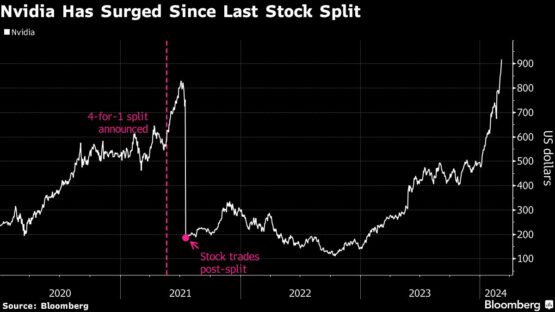Nvidia Corp’s scorching rally has added more than $1 trillion in value this year alone, sending it well above the level where it last split its shares. Some see the AI giant well placed to do so again.
The company last announced a four-for-one stock split in May 2021, when it was trading at about $600 per share. Today, the stock is nearing the $1 000 level, extending last year’s 240% surge. While bulls argue that its valuation based on future earnings growth is relatively cheap, some potential investors may balk at the price.
ADVERTISEMENT
CONTINUE READING BELOW
“Probably in the next year or so, I expect the stock to split and that would be able to get some small retail investors into the stock where they think it’s out of reach right now,” said Ken Mahoney, president and chief executive officer of Mahoney Asset Management.
The reasoning Nvidia gave for 2021 split was “to make stock ownership more accessible to investors and employees,” according to a press release. It rallied to about $750 per share by July 19 that year — the day before it started trading on a split adjusted basis. After a 2022 drop, the shares have since blasted past those levels.
Stock splits are a cosmetic move generally enacted to attract smaller investors. The action reduces share price by redistributing the amount of equity over a larger number of stock, but doesn’t change anything about underlying fundamentals or valuation.
“I’m always of two minds,” said Mike Sansoterra, chief investment officer at Silvant Capital Management LLC, adding that on one hand, stock splits don’t matter much because they don’t change anything about a company’s value.
“But, on the other hand, retail investors psychologically do like to buy things that are $30 instead of $300,” he said. “They tell themselves that it’s less expensive even though it’s absolutely not less expensive.”
To be sure, Nvidia hasn’t made any indication that it would split its shares anytime soon, and with its rally still marching higher, it doesn’t seem to be scaring away all retail investors. Its one of the most-traded stocks for the retail crowd, alongside Tesla Inc, Advanced Micro Devices Inc and Super Micro Computer Inc, according to data from Vanda Research.
And, investors that aren’t ready to pony up Thursday’s closing price of about $927 could still buy fractional shares of Nvidia, or hold fewer units.
In addition, no companies in the Nasdaq 100 split their stocks last year amid a market-leading tech rally. That was a reversal from just a few years earlier during the pandemic, when technology stocks soared and spurred splits in some of the largest companies.
Both Apple Inc. and Tesla Inc. split their shares in 2020 — with the move being the EV maker’s second in a two-years span. Amazon.com Inc. and Alphabet Inc. both split their stocks in 2022. Microsoft, however, hasn’t split its own shares since 2003, when it traded at about $50. It’s now trading at more than $400.
If Nvidia can continue to exhibit consistent growth on an upward trajectory, a stock split “would make sense,” Mahoney said.
ADVERTISEMENT
CONTINUE READING BELOW

A positive outlook for revenue and cash flow in 2024 has been one of the factors lifting International Business Machines Corp. back toward a record high set more than 10 years ago. The firm has focused on streamlining its operations around software and services in recent years, divesting other businesses.
Top tech news
Recruiters are eager to use generative AI, but a Bloomberg experiment found bias against job candidates based on their names alone
China is in the process of raising more than $27 billion for its largest chip fund to date, accelerating the development of cutting-edge technologies to counter a US campaign to thwart its rise.
Huawei Technologies Co and its partner Semiconductor Manufacturing International Corp relied on US technology to produce an advanced chip in China last year, according to people with knowledge of the matter.
Broadcom Inc, a chip supplier for Apple Inc. and other big tech companies, predicted that AI spending would fuel growth more quickly than expected this year, even as sluggish demand in other areas weighs on semiconductor sales.
© 2024 Bloomberg

